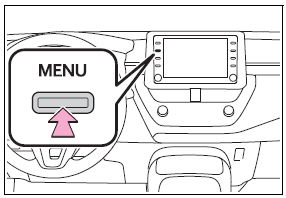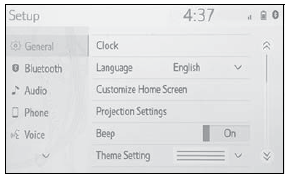Toyota Corolla: Steps to take in an emergency / If the engine will not start
If the engine will not start even though correct starting procedures are being followed, consider each of the following points:
The engine will not start even though the starter motor operates normally.
One of the following may be the cause of the problem:
- There may not be sufficient fuel in the vehicle’s tank. Refuel the vehicle.
- The engine may be flooded. Try to restart the engine again following correct starting procedures.
- There may be a malfunction in the engine immobilizer system.
The starter motor turns over slowly, the interior lights and headlights are dim, or the horn does not sound or sounds at a low volume.
One of the following may be the cause of the problem:
- The battery may be discharged.
- The battery terminal connections may be loose or corroded.
The starter motor does not turn over (vehicles with a smart key system)
The engine starting system may be malfunctioning due to an electrical problem such as electronic key battery depletion or a blown fuse. However, an interim measure is available to start the engine.
The starter motor does not turn over, the interior lights and headlights do not turn on, or the horn does not sound.
One of the following may be the cause of the problem:
- The battery may be discharged.
- One or both of the battery terminals may be disconnected.
- There may be a malfunction in the steering lock system.
Contact your Toyota dealer if the problem cannot be repaired, or if repair procedures are unknown.
Emergency start function (vehicles with a smart key system)
When the engine does not start, the following steps can be used as an interim measure to start the engine if the engine switch is functioning normally. Do not use this starting procedure except in case of emergency.
1 Set the parking brake.
2 Check that the shift lever is in P (continuously variable transmission) or N (manual transmission).
3 Turn the engine switch to ACC.
4 Press and hold the engine switch for about 15 seconds while depressing the brake pedal (continuously variable transmission) or clutch pedal (manual transmission) firmly.
Even if the engine can be started using the above steps, the system may be malfunctioning. Have the vehicle inspected by your Toyota dealer.
 Installing the spare tire
Installing the spare tire
1 Remove any dirt or foreign matter from the wheel contact surface.
If foreign matter is on the wheel contact surface, the wheel nuts may loosen
while the vehicle is in motion, causing the tire to come off...
 If you lose your keys
If you lose your keys
New genuine keys can be made by your Toyota dealer using the other key (vehicles
without a smart key system) or mechanical key (vehicles with a smart key system)
and the key number stamped on your key number plate...
Other information:
Toyota Corolla 2019-2025 Owners Manual: Entering keyword operation
A keyword can be entered to an application by the software keyboard or voice recognition function. The keyboard layout can be changed. Entering a keyword using the software keyboard 1 Display the application screen. 2 Select the desired application screen button...
Toyota Corolla 2019-2025 Owners Manual: Windshield wiper de-icer
Prevent ice from building up on the windshield and wiper blades. When the windshield wiper de-icer switch is on, the indicator illuminates on the windshield wiper de-icer switch. The windshield wiper de-icer will automatically turn off after a period of time...
Categories
- Manuals Home
- 12th Generation Corolla Owners Manual
- Sensors
- Maintenance and care
- General settings
- New on site
- Most important about car
General settings
Settings are available for clock, operation sounds, etc.
Displaying the general settings screen
1 Press the “MENU” button.

2 Select “Setup”.
If the general settings screen is not displayed, select “General”.
3 Select the desired items to be set.

